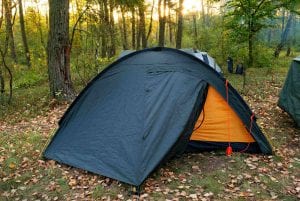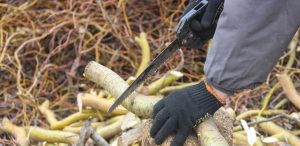There are literally hundreds of tarp configurations you can use (and just to be extra helpful, each configuration has multiple names). To simplify things, I’m going to preach that there are only a 4 different configurations you need to know. Here they are:
The A-Frame Pitch
The A-frame is a common tarp configuration that offers good protection from light wind and rain.
With a high ridgeline and long guys it can be a fairly open canopy that you can sit under and look out at the world. Or you can use a low ridgeline and staking down with short guys to create a much more enclosed space with more protection.
It’s dead easy to set up. To do this, you need two anchor points of equal height at least 10′ apart (the distance depends on the size of your tarp). Trees are perfect. You can also do this with tarp poles. Or you can mix and match; some folk might use their vehicle as one anchor point, and a tree or a pole as another.
Setup
1. You want to create a ridgeline, so tie some paracord to one anchor point as high as you want (5ft is good for a fairly enclosed shelter) then stretch it tight and tie it off at the other anchor point (same height off the ground).
2. Throw your tarp over the ridgeline so that the centre of the tarp sits on the cord.
3. Guy out the corners so everything is nice and taut with no sagging. Use any other guy out points you need depending on the weather conditions.
Because both ends are exposed, make sure one of the long sides is facing into the wind (because pitching a short side into the wind will create a wind tunnel).
It’s got great ventilation and can easily check out your surroundings from underneath. It’s not the best for a storm, although when you shorten your guylines and get a tighter pitch, you get much more protection from the elements.
Although it does not have a floor and can be prone to sagging, it is one of the quickest and easiest pitches to assemble.
Diamond Pitch: Perfect for Bad Weather
This is a great pitch if you want to have three sides closed to the elements and one side wide open. It’s kinda like a mini cave so it’s perfect for keeping out wind or horizontal rain!
Start by tying one corner to a tree with the wind to your back. For larger tarps you can go about 6′ up. Go lower if you have a smaller tarp or want a lower profile. Then go to the opposite corner and stake it out tight. And lastly, stake out the sides. With the weather approaching from behind, you’ll have a nice, sheltered spot with a large opening.

The Flying Diamond Tarp Pitch
A common variation of this is the “flying diamond pitch” which involves elevating the the back as well as the front (using trees or poles), and staking out the sides with guy lines rather than stake them directly into the ground. So instead of having the corners staked and the tarp edges flush to the ground, you great a few inches’ gap between the tarp and the ground.
This will create more airflow if you want a breeze because of the heat or bugs.
Tarp Lean-To: Great Beginner Pitch
The lean-to shelter is also quick to make, and probably the best to try as a first-timer. You will need two trees, and you want to make sure there is no slack at all in the line. Throw the tarp over the line, pulling it at a thirty-degree angle. Hammer stakes in on each end, ensuring that they are on the outside of the shelter.
It’s a good one because it’s so easy to setup. It also overs great wind protection from one side. The downsides are that you are still left exposed on three sides. And you also won’t have a floor (which means you’ll either want to carry a second tarp to act as a floor or use a bivvy).
How to Make a Tarp Shelter Without Trees? Use the One-Stick Pitch!
No trees? No worries. You can also make a tarp shelter with one stick. It can be erected in less than five minutes. Simply place a pole in the center of where you would like to camp, then drape your tarp over the top. Stake the corners in on three sides, making a triangle shape. This will offer resistance to heavy winds, as there won’t be any sides for the wind to catch. While it can be a bit claustrophobic, it’s a quick and easy pitch that will work well if you have no trees to depend on.
Tarp Shelter Setup: Where & How to Pitch a Tarp
One of the biggest differences between using a backpacking tarp and a tent (aside from the obvious) is site selection. Because you are naturally going to be more exposed, you need to become really smart about choosing where to locate your camping tarp setup. A few tips:
1. Try to avoid well-used pitches where the ground in hard as rock. Instead, seek out lesser-used sites or virgin ground.
2. You must look for sheltered spots. Become an expert in how wind moves over ground and look for places that aren’t buffeted too much. At the same time, beware no air circulation at all! You don’t want to invite the mosquitoes over for a fireside dinner.
3. When you set up your tarp, remember that drainage is key. You want to make sure you are not at the bottom of a hill, where runoff will become your enemy.
4. Keep in mind that cold air sinks, so if you are low on a hillside, this might be nice in the summertime but will also present other challenges (like high humidity).
5. As with any sort of camping, keep in mind how close you are to resources like drinking water and firewood.





